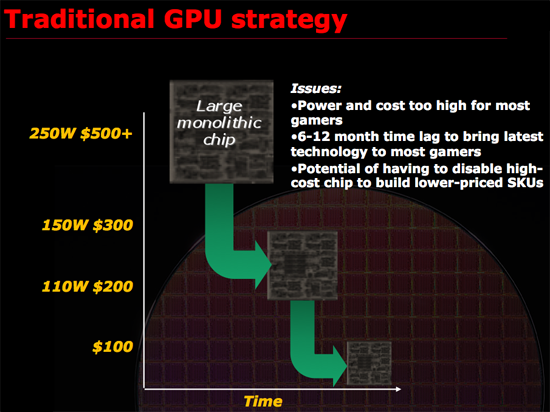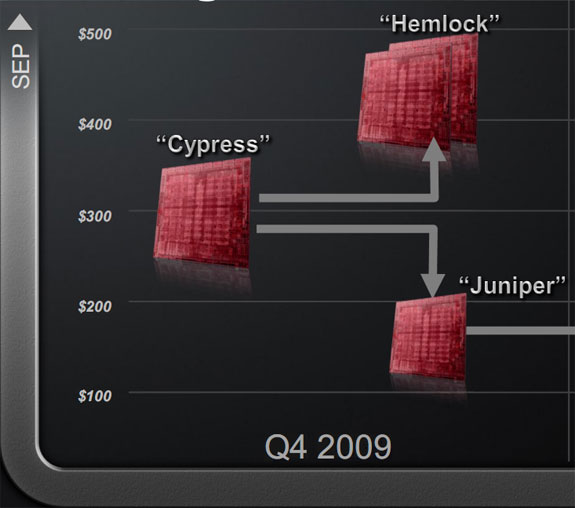The RV870 Story: AMD Showing up to the Fight
by Anand Lal Shimpi on February 14, 2010 12:00 AM EST- Posted in
- GPUs
What Made it All Ok: 4 GPUs in < 6 Months
Through a lot of hard work and sacrifice, even on Carrell’s part, ATI cut the RV870 from as much as 22mm on a side down to roughly 18mm x 18mm. The problem is that RV770 was around 16mm on a side. The RV870 was still too big.
Carrell wanted to cut it down even more, but two things changed his mind. First, in order to build 870 in the space of a 770 ATI would have to cut out much more from the chip than Carrell originally tought. One of the things that would have to go was some of the shader core.
In order to run the GDDR5 memory at the sort of data rates that ATI was targeting for the 5870 the analog PHYs on the chip had to grow considerably. At 16mm on a side ATI would either have to scale back memory bandwidth or eat into the shader core area. Either way we would’ve had a slower chip.
I asked Carrell if 16mm on a side would’ve made the RV870 $100 cheaper at launch, putting it on par with the RV770 launch prices. He said no. I didn’t find out why until much later, but I’ll save that story for another time.
Sacrificing performance to meet the 16mm x 16mm die size targets wasn’t going to happen, but what ultimately convinced Carrell to go with a larger die this time around was something that ATI didn’t get nearly enough praise for: the ability to launch 4 different 40nm DirectX 11 GPUs in less than 6 months.
Remember that Carrell’s beef with building the biggest GPU possible is that it takes too long for the majority of customers to get access to derivatives of that GPU. Look at how long it took G80 or GT200 to scale down. And who knows when we’ll see $150 Fermi/GF100 derivatives.

But ATI Engineering promised two things. First, that Cypress would have a successor called Juniper that would be ready around the same time. Secondly, two more GPUs would follow and the whole stack will be done and out in less than 6 months. ATI came close in 2008 with 3 GPUs in 3 months, but the fourth member of the 4000 series didn’t show up until April of 2009.
It wasn’t an impossible feat. ATI does have concurrent design teams and a lot of engineering resources in India/China. By working on Juniper in tandem with Cypress, assuming there were no show stopping bugs, ATI could exploit efficiencies in two teams effectively working on the same hardware (Juniper was just half a Cypress).
The idea of taking such a huge risk made Carrell uncomfortable. Running two GPU designs in parallel, for the same family of chips, is risky. If everything works out perfectly, you get two chips out at the same time. If it doesn’t, you’ve just tied up two design teams on one product generation. A slip here would give ATI its own Fermi.
What ultimately sold Carrell was the fact that engineering told him that they believed they could pull it off. Carrell believes in people. He believes if you expect the best out of those around you, then that’s what you’ll get. He couldn’t reconcile his beliefs with doubting the schedule engineering was feeding him. Carrell nervously signed off and the Evergreen stack was born.

Cypress and Juniper were delivered nearly at the same time. In fact, Juniper was ready a bit earlier and was sampled to developers months before ATI launched the 5000 series. Cedar and Redwood followed, not to mention a dual-Cypress board that became the Radeon HD 5970. And all of this was done and ready in less than 6 months (the chips themselves were all ready within 4 months).
When the smoke cleared ATI had new DirectX 11 parts at $600, $400, $300, $200, $150, $100 and $60. The Windows 7/DirectX 11 market bulge just got serviced.










132 Comments
View All Comments
simtex - Sunday, February 21, 2010 - link
Excellent article ;) Insider info is always interesting, makes me a little more happy about my -50% AMD stocks, hopefully they will one go up again.NKnight - Wednesday, February 17, 2010 - link
Great read.- Friday, February 19, 2010 - link
you should write a (few)book(s); of course in multi eReader formats
asH
- Saturday, February 20, 2010 - link
Nvidia blames sales shortfall on TSMChttp://www.eetimes.com/news/latest/showArticle.jht...">http://www.eetimes.com/news/latest/show...E1GHPSKH...
one dot you didnt connect in the article was AMD's foundry experience, which gives AMD a big advantage over NVIDIA; must have been an oversight?
asH
truk007 - Tuesday, February 16, 2010 - link
These articles are why I keep coming here. The other sites could learn a lesson here.dstigue1 - Tuesday, February 16, 2010 - link
I think the title says it all. But to add I also like the technical level. You can understand it with some cursory knowledge in graphics technology. Wonderfully written.sotoa - Tuesday, February 16, 2010 - link
Excellent work and very insightful indeed!juzz86 - Tuesday, February 16, 2010 - link
An amazing read Anand, I can wholeheartedly understand why you'd enjoy your dinners so much. One reader said that these were among the best articles on the site, and I have to agree. Inside looks into developments in the industry like this one are the real hidden gems of reviewing and analysis today. You should be very proud. Thanks again. Justin.talon262 - Tuesday, February 16, 2010 - link
Hell of an article...congrats to Anand for putting it out there and to the team at ATI for executing on some hard-learned lessons. Since I have a 4850 X2, I'm most likely going to sit Evergreen out (the only current ATI card that specs higher than my 4850 X2 (other than the 4970 X2) is Hemlock/5970 and Cypress/5870 would be a lateral move, more or less); while I run Win7, DX11 compatibilty is not a huge priority for me right this moment, but I will use the mid-range Evergreen parts for any systems I'll build/refurb over the next few months.Northern Islands, that has got me salivating...
(Crossposted at Rage3D)
Peroxyde - Monday, February 15, 2010 - link
Thanks for the great article. Do you have any info regarding ATI's commitment to the Linux platform? I used to see in Linux forums about graphics driver issues that ATI is the brand to avoid. Is it still the case?